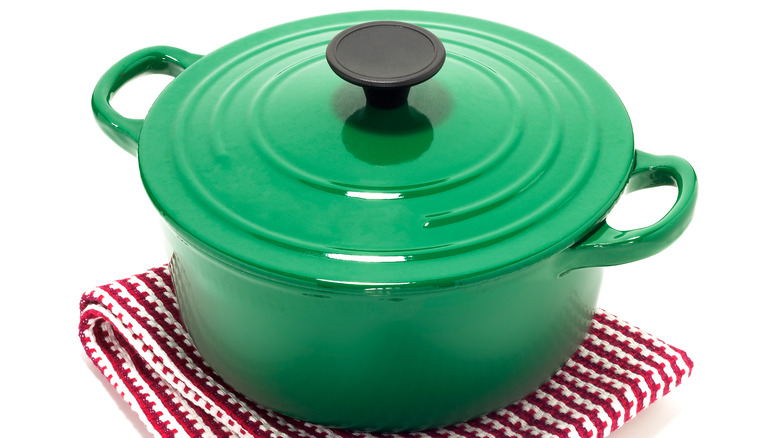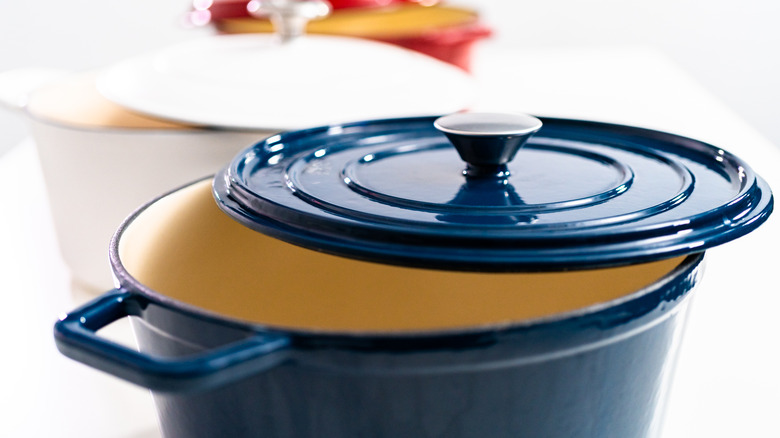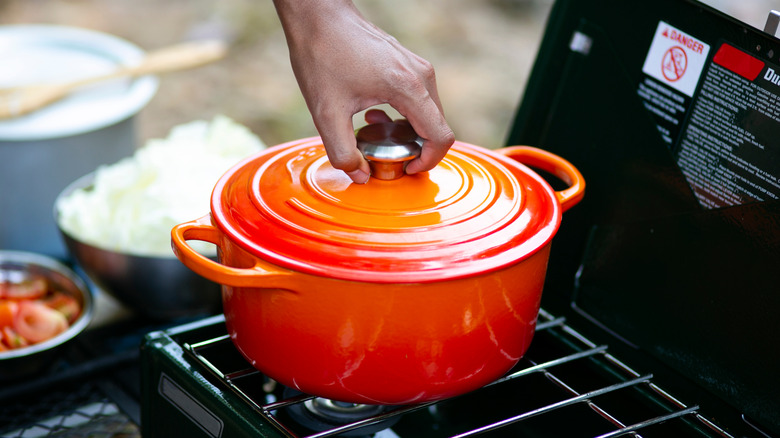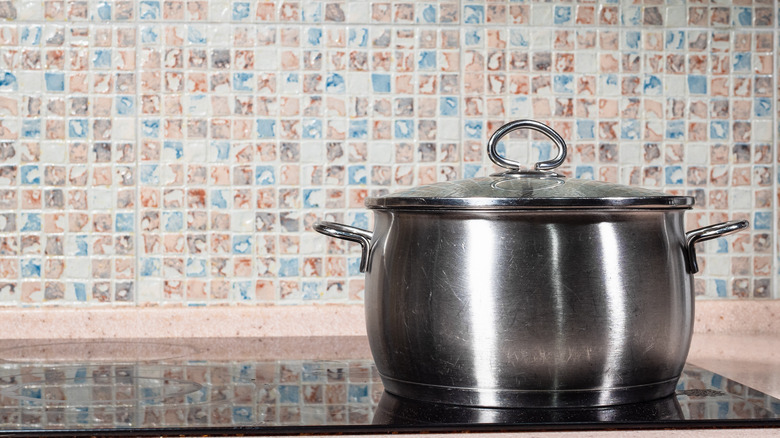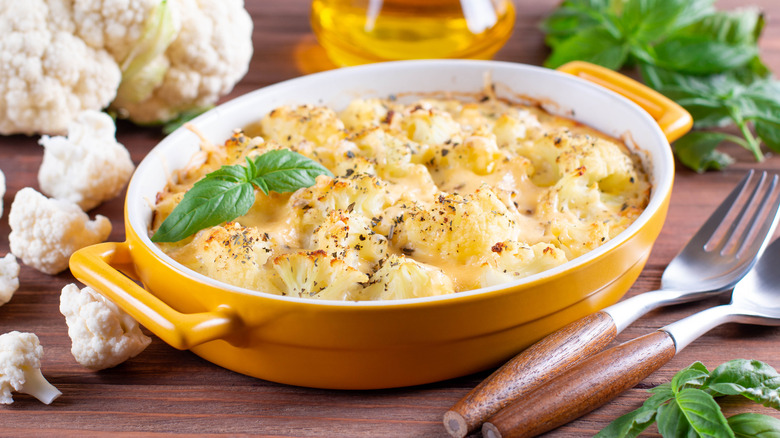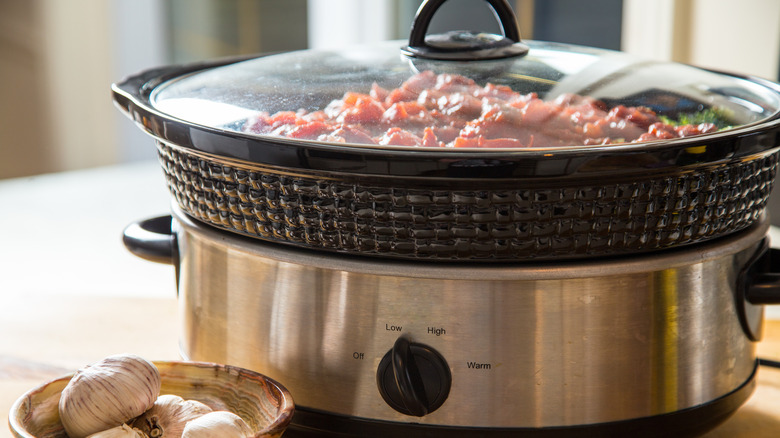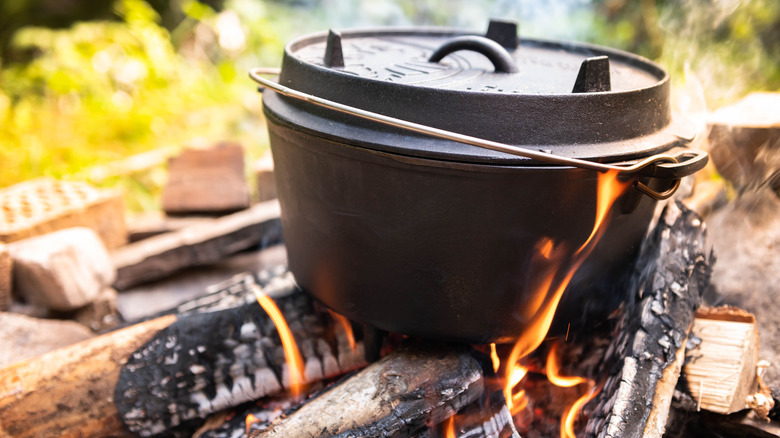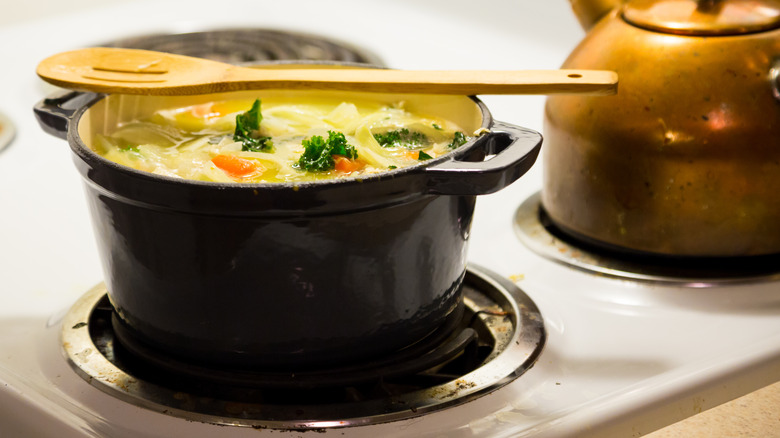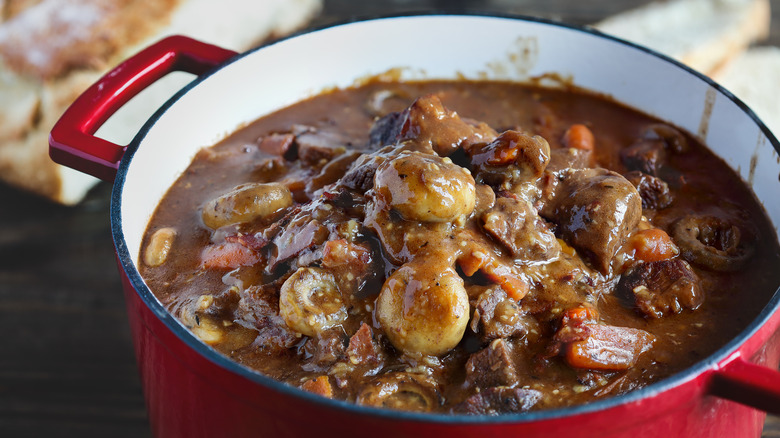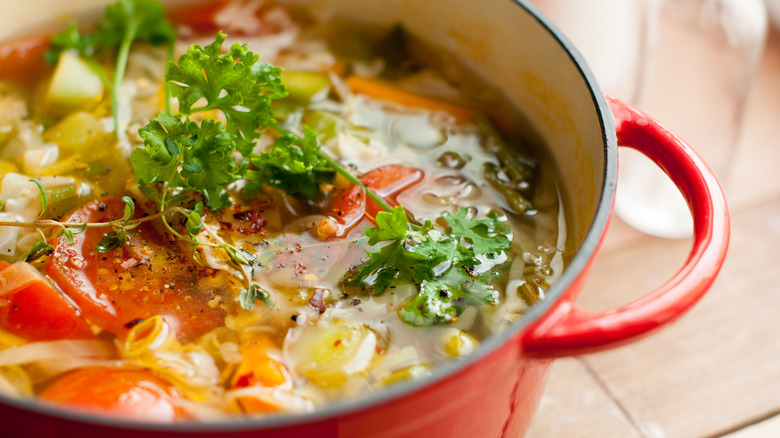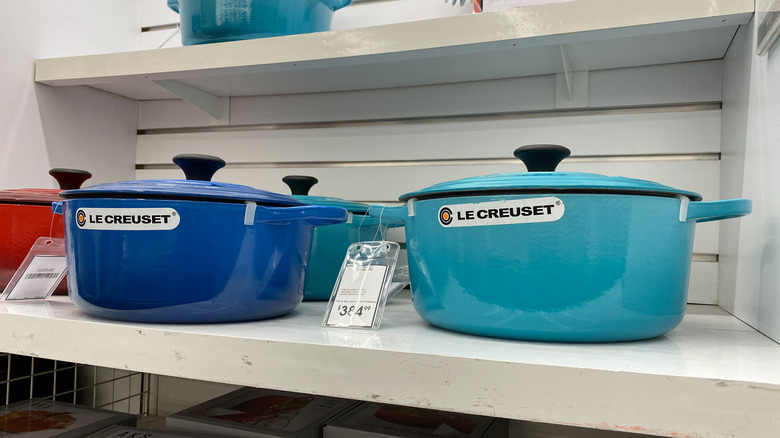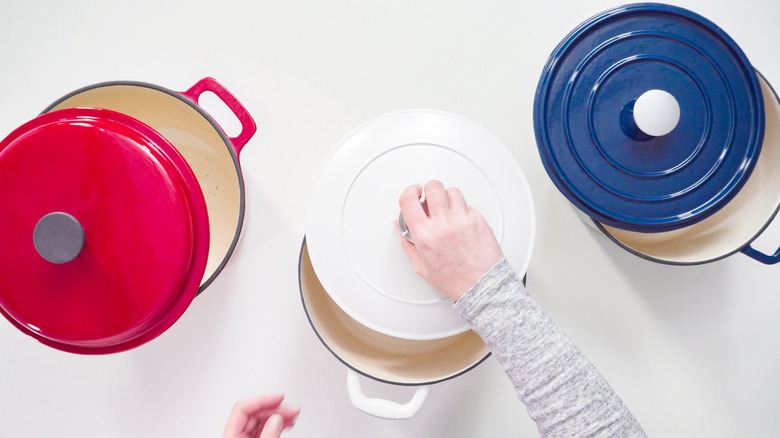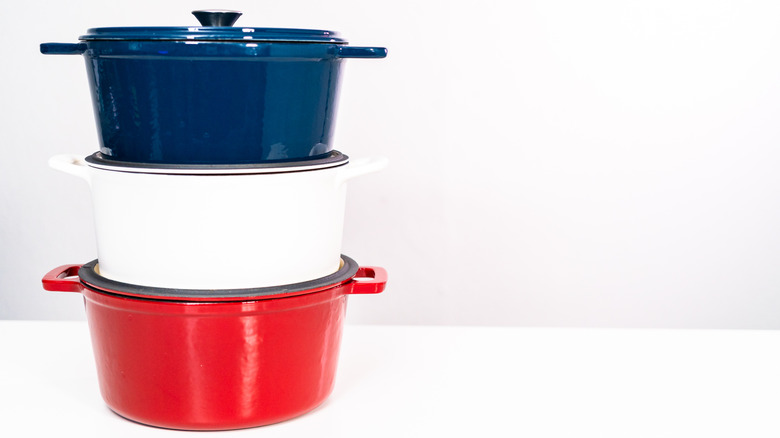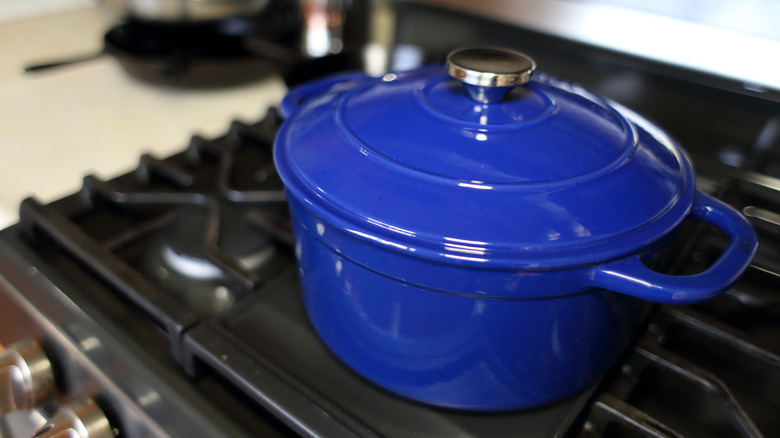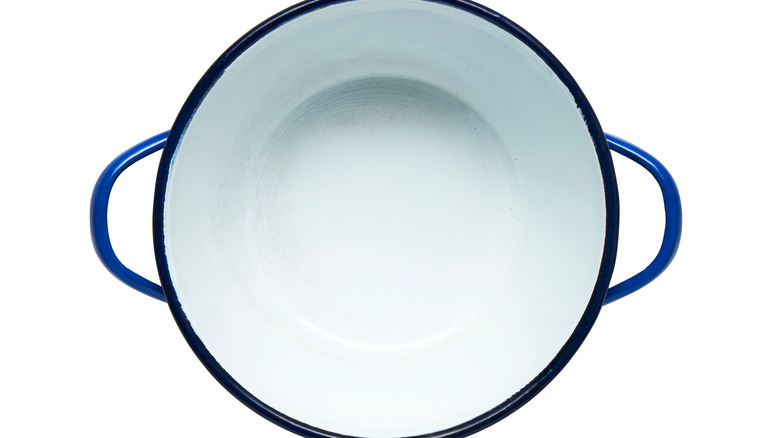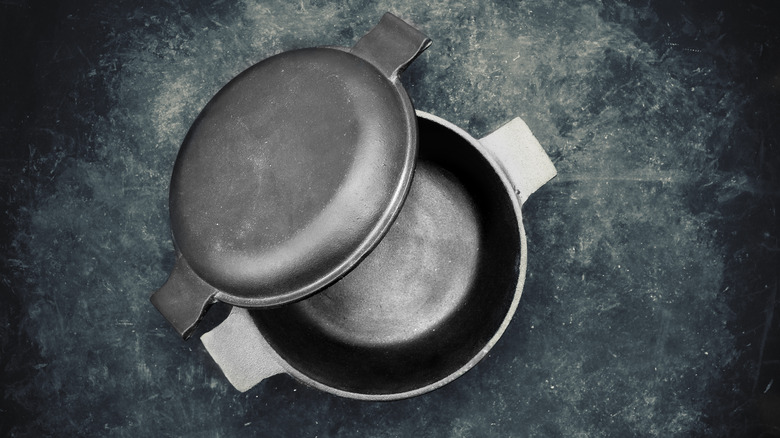What Is A Dutch Oven And Why Do You Need One
When it comes to kitchenware it can sometimes feel like you need the latest equipment in order to make a simple dinner. A walk through any home appliance store reveals an ever-changing display of new products, each aimed at helping you cook with greater ease. But in reality, tried and true pots and pans like a Dutch oven can take you far.
Some form of Dutch ovens have been around for hundreds of years, however, with a recent rise in popularity, they've never been more popular. While colorful models by the iconic manufacturer Le Creuset are surely in part responsible for the current craze, Dutch ovens wouldn't be so adored if they didn't make a difference in the kitchen. Of course, once you make up your mind to purchase a Dutch oven, you will want to consider various factors to pinpoint the right design for your purposes. More importantly, you will have endless occasions to use this essential kitchen tool. (Hint: It's not just meant for soups and stews!). Here's everything you need to know about purchasing a Dutch oven and what to do with it once its in your kitchen arsenal.
What is a Dutch oven?
With a constant influx of products taking over the market, it can be confusing to understand what makes each one distinct. The general consensus is that a Dutch oven consists of a wide pot that is relatively shallow and fitted with a tight lid to retain heat. As well, the pot has a thick base and walls that keep its internal temperature stable. These characteristics make it suitable for browning, braising, roasting, baking, and even simmering. Dutch ovens have a handle on either side, which you will appreciate when trying to lift the weighty dish. They also come in a range of colors, sizes, and materials if you want to make a stylistic statement.
You would be right to assume that the Dutch were responsible for the popular piece of cookware. The Kitchn indicates that the design originates from the Netherlands, where in the 17th century, a revolutionary mold made of sand was developed for casting metal. The resulting smooth finish was ideal for iron cookware that spent hours over heating up over a fire. Nowadays the pot is made around the world but nevertheless, the name stuck.
Do you need a Dutch oven?
Of course, needs are relative and while a microwave and toaster can be sufficient for one home cook, another might require the latest range of kitchen appliances. While you can certainly feed yourself without owning a Dutch oven, a handful of factors make them a worthwhile investment.
If you enjoy cooking or are eager to streamline the process, Dutch ovens are a great tool thanks to their versatility. They can be used in countless ways to make an unlimited amount of dishes. Instead of getting a saucepan, stockpot, and casserole dish dirty, a Dutch oven can act as a chameleon, shifting roles based on your needs. According to OvenSpot, uniform heat circulation means that your food cooks evenly without the need for constant surveillance. Thanks to the tightly sealed lid, instead of losing flavor to evaporation, the condensation settles back onto the food, enhancing the taste.
While the price tag for a Dutch oven regularly reaches triple digits, it is not necessary to spend top dollar. If you do choose to splurge, devotees praise the fact that Dutch ovens last a lifetime, and then some.
Dutch oven vs stockpot
At a quick glance, a Dutch oven looks like a stockpot made from cast-iron instead of stainless steel. Indeed, the two have similarities in appearance such as tall walls and two handles. However, Cookware Insider explains that a stockpot is taller and lighter, ideal for holding a lot of ingredients and liquid. This makes it a great option for soups, broths, and any recipe that requires you to pour off the liquid. Meanwhile, Dutch ovens tend to be shorter and much heavier, making it challenging to drain off excess liquid.
Since Dutch ovens are thicker, they maintain a constant temperature once they finally warm up, radiating heat so that ingredients cooks evenly. OvenSpot pointedly notes that stainless steel pots don't share this quality. A thick structure means that Dutch ovens can be used on the stovetop and in the oven, which makes them a good option for recipes that involve braising food for a longer duration (via Cookware Insider). Meanwhile, stockpots aren't suitable for the oven, partly because they are much thinner and usually too tall to fit.
While you could probably get by with just one of the two pieces of cookware, if you have a wide cooking repertoire that includes soups, broths, slow-cooked meats, roasts, then both will be practical.
Dutch oven vs casserole
A casserole and Dutch oven are regularly interchanged, a confusion that Pediaa attributes in part due to mislabeling by manufacturers and recipes. The main difference between the two is functional, and Pediaa explains that casserole dishes are only meant for the oven whereas Dutch ovens can transition to the stovetop. This characteristic makes casseroles less versatile and not always a possible substitute for Dutch oven recipes.
Casseroles are usually larger and shallower, perfect for cooking the meal by the same name. They can be made from glass, ceramic, aluminum, and cast-iron, the latter being the material of choice for Dutch ovens. Dutch Ovens Cookware points out that since casseroles are generally much lighter, they are easier to clean. On the flip side, materials used for casseroles tend to be more fragile, unlike cast-iron which just requires proper maintenance. The two pieces of cookware come with a tightly fitted lid that allows heat to circulate, cooking the food evenly. Thanks to handles at either end, both Dutch ovens and casseroles can easily be placed on the table to serve.
Dutch oven vs slow cooker
Although a Dutch oven is ideal for slowly cooking food, it is not a slow cooker. According to Slow Cooking Perfected, a slow cooker is a pot that incorporates an electrical heating element. This means that it can be plugged into an outlet without needing to use an oven or stovetop. You simply choose a heat setting and duration and let the cooking happen. That means that you can toss ingredients into your slow cooker in the morning and conveniently come home to dinner.
This hands-off quality has its advantages, but it also means that the cook has less control over the process. With a Dutch oven, you can easily brown, simmer, or braise the same preparation to enhance the overall flavor. The general consensus is that the results from a slow cooker lack taste in comparison and are not as nutritionally dense. Nonetheless, the electric pot has its uses and The Kitchn remarks that it is particularly useful for tenderizing large tough pieces of meat.
Are all Dutch ovens resistant to high temperatures?
Handles made of non-heat resistant materials such as plastic or wood are the main issue regarding oven use for Dutch oven (via Dutch Ovens Cookware). OvenSpot recommends informing yourself regarding your specific model of Dutch oven because there are even differences in heat resistance within the same manufacturer. Dutch Ovens Cookware indicates that popular models generally range from 375 to 500 F when it comes to heat resistance. Let's face it, unless you are regularly cooking over an open fire, 500 F should be hot enough for your needs. If you're looking for more, Oven Spot suggests seeking out seasoned cast-iron. Heat resistant up to 700 F, it will cover even the most experimental home cook applications.
Finally, besides maximum temperatures and materials, there are precautions to ensure your Dutch oven handles heat well. OvenSpot warns against heating your cookware if there is no liquid or fat on the bottom of the pot. Dutch ovens will hold onto heat so it isn't necessary to cook at maximum temperatures. Also, avoid switching between temperature extremes to prevent the enamel coating from cracking.
How to cook with a Dutch oven
When cooking meat, heat the pot with oil and work in batches to properly brown the exterior. Dutch oven lids are known for being airtight which is helpful to retain moisture. However, if you are slowly reducing a sauce, leave the lid off or slightly open to allow water to evaporate.
While you might be used to raising the heat on your stockpot to a maximum, since a Dutch oven retains heat you don't have to the temperature to extremes. Real Simple advises sticking with a low and slow method that allows the flavors to develop over time while the ingredients cook. Since ingredients are browned and then simmered or braised over time, the flavor tends to be enhanced thanks to the multi-step process. Just remember not to over-season during the braising process since all of the moisture and flavor will continue to cycle through the dish.
What recipes can you cook in a Dutch oven?
Part of a Dutch oven's allure is the wide range of cooking options it provides. Since you can sear, simmer, braise, bake, roast, and more, there's no shortage of Dutch oven recipes you can prepare with the sturdy cookware. Thanks to the characteristics of the pot, it is ideal for cooking meat for long durations until it tenderizes. The durable material allow you to first brown the meat in the pot and then continue cooking it with liquid in the oven. If your Dutch oven is big enough, you can even use it to roast a whole chicken.
Any preparation such as a stew or soup that requires a lengthy cook time will benefit from the Dutch oven's tightly fitted lid. Basically, the cookware is perfectly suited for your one-pot wonders (chili anyone?). You cook everything from pasta, risotto, oxtails, or stuffed peppers in the versatile pot. Although it might not be the first use that comes to mind, Today even suggests using a Dutch oven for your deep frying needs. We'll dive further into baking bread in a Dutch oven but the possibilities don't stop at crusty sourdough. Cornbread, brownies, and cakes can all be baked in the multipurpose piece of cookware.
Why should you make bread in a Dutch oven?
While rectangular sandwich loaves aren't the best fit for a Dutch oven, it works wonders for no-knead and sourdough bread thanks to the lid's airtight seal. This allows a buildup of steam inside the pot which ultimately produces a crusty exterior on the bread as well as air bubbles in the dough (via King Arthur Baking). In fact, Food52 identifies steam as the secret ingredient needed to make bakery-quality bread at home. This keeps the exterior of the dough damp so that it can stretch and grow from the inside out. While most people don't have steam ovens in their own kitchens, the effect can be mimicked with a Dutch oven.
The best technique to trap steam is to preheat the Dutch oven before adding the risen dough (via Food52). Right before adding the dough, cut some slits across the top so that the heat can escape uniformly (via The Bread Guide). The Perfect Loaf suggests sprinkling cornmeal on the bottom of the pot to prevent sticking and transferring the dough on parchment paper into the pot. Once the humid dough is inside the pot and the lid is sealed, steam will begin to build up. Then, depending on the size, remove the lid after 25 minutes to allow the crispy crust to brown without becoming soggy. Once you get the hang of it you might just skip the bakery!
Is food cooked in a Dutch oven healthier?
Whether cooking with a Dutch oven offers any health benefits depends on its application. For example, if you are using it to deep fry all of your meals then you won't see any positive outcomes. However, since a Dutch oven provides a container where flavors can develop, home cooks don't need to add as many ingredients to enhance the taste. This can be a healthy quality if you cook with a lot of oil or butter for richness. Dutch ovens Cookware adds that since the lid creates an airtight seal, nutrients do not evaporate as easily as with other cookware. This means you won't be losing precious vitamins and minerals while cooking a dish low and slow for hours.
Some Dutch ovens are made from cast-iron without a coating whereas others have enamel to protect the exterior. A study published by the Journal of the American Dietetic Association back in 1986 confirmed that cooking in iron cookware resulted in a transfer of iron into the food. There are variations depending on what you cook and acidic food is especially reactive (via Nourished Kitchen). Nonetheless, there is no conclusive evidence to suggest that the iron content becomes absorbed in any significant amount by the consumer (via The Kitchn).
What are common mistakes when using a Dutch oven?
As far as cookware goes, Dutch ovens are fairly straightforward. However you will want to keep a few basic pointers in mind to ensure success. Not only will your food taste better but the Dutch oven will stay in better condition over time — it's supposed to last a lifetime, remember?
It's easy to think that the quickest way to increase the temperature of your Dutch oven is by setting your burner to high, but this method isn't helpful in the long run. Although the pot will take some time to heat up, once it is warm it retains heat exceptionally well. Consequently, The Kitchn advises sticking to low or medium heat and making sure there is some liquid in the pot to prevent burns and deterioration over time. Similarly, be sure to avoid large shifts in temperature or your enamel-coated Dutch oven risks cracking.
The Kitchn notes that another obvious way to ruin the quality of your pot is by outright scratching it with the wrong type of utensil. While you don't need fancy new equipment, using wood and silicone will keep your Dutch oven in a better state than applying contact with metal. Depending on the material of your cookware, different care is required so be sure to follow the recommendations for your model. If there is rust on your cast-iron Dutch oven, you're doing something wrong!
Where to buy a Dutch oven
As with almost anything these days, you can buy a Dutch oven online. This means that you can evaluate endless options before making your selection. If you like having many choices then this is an advantage, but it also means you should have a good idea of what you want to avoid becoming overwhelmed.
A downside of online shopping is that reading size measurements in quarts isn't as intuitive as holding the pot in your hands. Nevertheless, you can both buy and receive a Dutch oven without having to leave your home, which is handier than lugging the heavy piece of cookware from the store. Thankfully, many manufacturers waive the shipping cost for larger purchases, eliminating extra costs for the weight.
If you're still fond of doing your shopping in person, most kitchenware retailers stock Dutch ovens. Smaller stores might only sell one brand whereas department stores generally have a range of prices and options. You will be able to see the physical characteristics up close and perhaps benefit from in-store offers.
What material is ideal for your needs?
Although the distinction is not commonly specified, Allrecipes clarifies that a Dutch oven is a cast-iron vessel while a French oven is coated with enamel. Pure cast-iron is highly praised by cooks, however, it needs to be treated with care in order to stand the test of time. Everything Kitchens points out that the material's durability makes it an option for campfire cooking. If you've ever cooked with cast-iron then you will know that the surface affects flavor to a certain extent. Unfortunately, it is not suitable for cooking highly acidic foods so if tomato sauce is regularly featured in your cooking repertoire, then you might want to rethink bare cast-iron.
If you want the benefits of cast-iron without any flavor transfer and simpler maintenance, then enameled cast-iron is your best option. Allrecipes warns that they are the priciest option but are meant to last a lifetime or more. Plus you'll get to pick from a rainbow of colors! Ceramic Dutch ovens are another option, however, anyone who has accidentally cracked ceramic cookware is aware of its potential fragility. Nonetheless, these are certainly lighter than cast-iron, so if you want to avoid heavy kitchenware then ceramic is a good choice. Finally, there are some stainless steel options but they don't have the advantage of uniform heat distribution which is part of the appeal of a Dutch oven.
What factors should you consider when choosing a Dutch oven
If you plan to frequently use your Dutch oven and can afford a high quality option, the investment is worthwhile because it will probably outlive you. However, the costliest choice is not necessary and mid-range Dutch ovens carry many similar qualities. You'll notice that a handful of manufacturers have achieved almost cult-like status (ahem, Le Creuset), but lesser-known brands can be equally effective.
In terms of size, consider how many servings you want to fit in your pot. Are you cooking for one or a family of six? Next, think about the dishes you plan to make. Will you mostly use your cookware to bake bread or would you like it to fit a turkey? Eating Well points out that there's no use in buying a huge pot just in case because it will take ages to heat up. A 6 to 8-quart Dutch oven should satisfy the average home cook. This is where shopping in person can be helpful if your grasp on theoretical volumes is a bit shaky.
Dutch ovens are mainly round or oval but can also be square. While each shape serves a purpose, The Washington Post notes that round pots fit best on the stovetop providing even heat distribution. As far as color goes, besides aesthetics, keep in mind that a light-colored interior makes it easier to notice when your food starts to brown.
What is the difference between a budget and expensive Dutch oven?
The cost of a Dutch oven can easily approach $400 but affordable models can be found under $100. According to HuffPost. The costlier price tag of popular models like Le Creuset is a matter of quality control, design, lifetime warranty, and prestige. Nonetheless, many factors drive price and it can vary merely based on where it is produced and local labor costs.
The New York Times rated a Dutch oven under $100 that is made by Lodge as their top pick, pointing towards a Le Creuset model for $360 as a splurge. The two were similar enough that The Times was confident in directing consumers to a more affordable version unless they felt like shelling out for a prized brand name. Overall, regardless of whether you spend $60 or $360, most product testers recommend choosing a weightier Dutch oven which tends to be made from more durable materials (via HuffPost).
How should you clean and care for an enamel-coated Dutch oven?
If you're going to be spending a decent amount of money on a Dutch oven, then you had better take good care of it! For the best results seek out the manufacturer's cleaning recommendations for your specific model. Although some enamel-coated Dutch ovens are dishwasher safe, hand washing is preferable to keep it in tip-top shape.
With an enamel coating, your job is straightforward — a soak in soapy water and a soft dish sponge should do the trick. To tackle extra stubborn residue, Allrecipes recommends combining baking soda and water in a three to one ratio and leaving the mixture in the pot overnight. Be sure to avoid rough sponges or you may scratch and ruin the enamel coating. When the surface is clean (another reason why a light-colored interior is useful), a quick rinse and dry will finish it up.
How should you clean and care for a pure cast-iron Dutch oven?
If you already have a pure cast-iron pan then you know that it must first be seasoned. Taste of Home recommends spreading vegetable oil over the lid and pot with a paper towel. Then, bake it for one hour in an oven at 400 F, letting it cool for 30 minutes with the oven off before removing it. This step helps create a non-stick surface while preventing rust.
Every time you clean your Dutch oven after use, first remove food remnants with a spatula or paper towel (via Allrecipes). Next, pour some water inside and bring it to a boil to dislodge any extra food. Give it a good scrub (ideally without any dish soap), rinse the contents, and dry it with a paper towel. Finally, to keep your Dutch oven in good shape, use a paper towel to spread on another thin layer of oil.
